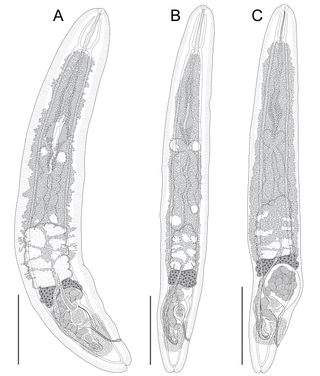
Gaucho literature, also known as gauchesco ("gauchoesque") genre was a literary movement purporting to use the language of the gauchos, comparable to the American cowboy, and reflecting their mentality. Although earlier works have been identified as gauchoesque, the movement particularly thrived from the 1870s to 1920s in Argentina, Uruguay and southern Brazil after which the movement petered out, although some works continued to be written. Gauchoesque works continue to be read and studied as a significant part of Argentine literary history.

Leucochloridium paradoxum, the green-banded broodsac, is a parasitic flatworm. Its intermediate hosts are land snails, usually of the genus Succinea. The pulsating, green broodsacs fill the eye stalks of the snail, thereby attracting predation by birds, the primary host. These broodsacs visually imitate caterpillars, a prey of birds. The adult parasite lives in the bird's cloaca, releasing its eggs into the faeces.
Cyclocoelidae is a family of trematodes in the order Plagiorchiida.

Moniliformidae is a family of parasitic spiny-headed worms. It is the only family in the Moniliformida order and contains three genera: Australiformis containing a single species, Moniliformis containing eighteen species and Promoniliformis containing a single species. Genetic analysis have determined that the clade is monophyletic despite being distributed globally. These worms primarily parasitize mammals, including humans in the case of Moniliformis moniliformis, and occasionally birds by attaching themselves into the intestinal wall using their hook-covered proboscis. The intermediate hosts are mostly cockroaches. The distinguishing features of this order among archiacanthocephalans is the presence of a cylindrical proboscis with long rows of hooks with posteriorly directed roots and proboscis retractor muscles that pierce both the posterior and ventral end or just posterior end of the receptacle. Infestation with Monoliformida species can cause moniliformiasis, an intestinal condition characterized as causing lesions, intestinal distension, perforated ulcers, enteritis, gastritis, crypt hypertrophy, goblet cell hyperplasia, and blockages.

Neoechinorhynchidae is a family of parasitic worms from the order Neoechinorhynchida.

Spirorchiidae is a family of digenetic trematodes. Infestation by these trematodes leads to the disease spirorchiidiosis. Spirorchiids are mainly parasites of turtles. It has been synonymised with Proparorchiidae Ward, 1921, Spirorchidae Stunkard, 1921, and Spirorchiidae MacCallum, 1921.
Oochoristica is a genus of tapeworms.

Opecoelidae is a family of trematodes. It is the largest digenean family with over 90 genera and nearly 900 species, almost solely found in marine and freshwater teleost fishes. It was considered by Bray et al. to belong in the superfamily Opecoeloidea Ozaki, 1925 or the Brachycladioidea Odhner, 1905.
Coitocaecum is a genus of trematodes in the family Opecoelidae. It has been synonymised to Ozakia Wisniewski, 1934, Paradactylostomum Zhukov, 1972 nec Toman, 1992, and Pseudocoitocaecum Bilqees, 1972.
Neolebouria is a genus of trematodes in the family Opecoelidae.

Echinostomatidae is a family of trematodes in the order Plagiorchiida, first described in 1899.
Strigeidae is a family of trematodes in the order Diplostomida.

Diplostomidae is a family of trematodes in the order Diplostomida.
Acanthotrema is a genus of trematodes in the family Heterophyidae.

Ancyrocephalidae is a family of monogenean flatworms. The family is considered as a "temporary name" in WorMS but includes a large number of genera and species.

Aporocotylidae is a family of trematodes within the order Diplostomida, which contains species commonly known as fish blood flukes. It contains more than 40 genera, the largest being Cardicola. Species in this family parasite fish in both fresh and marine water.

Clinostomum is a genus of trematodes in the order Diplostomida.










